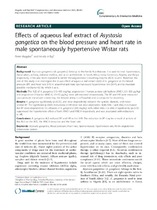Effects of aqueous leaf extract of Asystasia gangetica on the blood pressure and heart rate in male spontaneously hypertensive Wistar rats
Abstract
Background: Asystasia gangentica (A. gangetica) belongs to the family Acanthaceae. It is used to treat hypertension, rheumatism, asthma, diabetes mellitus, and as an anthelmintic in South Africa, India, Cameroun, Nigeria, and Kenya respectively. It has also been reported to inhibit the angiotensin I converting enzyme (ACE) in-vitro. Therefore, the aim of this study is to investigate the in-vivo effect of aqueous leaf extract (ALE) of A. gangetica on the blood pressure (BP) and heart rate (HR) in anaesthetized male spontaneously hypertensive rats (SHR); and to elucidate
possible mechanism(s) by which it acts. Methods: The ALE of A. gangetica (10–400 mg/kg), angiotensin I human acetate salt hydrate (ANG I, 3.1–100 μg/kg) and angiotensin II human (ANG II, 3.1–50 μg/kg) were administered intravenously. The BP and HR were measured via a pressure transducer connecting the femoral artery to a Powerlab and a computer for recording. Results: A. gangetica significantly (p<0.05), and dose-dependently reduced the systolic, diastolic, and mean arterial BP. The significant (p<0.05) reductions in HR were not dose-dependent. Both ANG I and ANG II increased the BP dose-dependently. Co-infusion of A. gangetica (200 mg/kg) with either ANG I or ANG II significantly (p<0.05) suppressed the hypertensive effect of both ANG I and ANG II respectively, and was associated with reductions in HR. Conclusions: A. gangetica ALE reduced BP and HR in the SHR. The reduction in BP may be a result of actions of the ALE on the ACE, the ANG II receptors and the heart rate.

